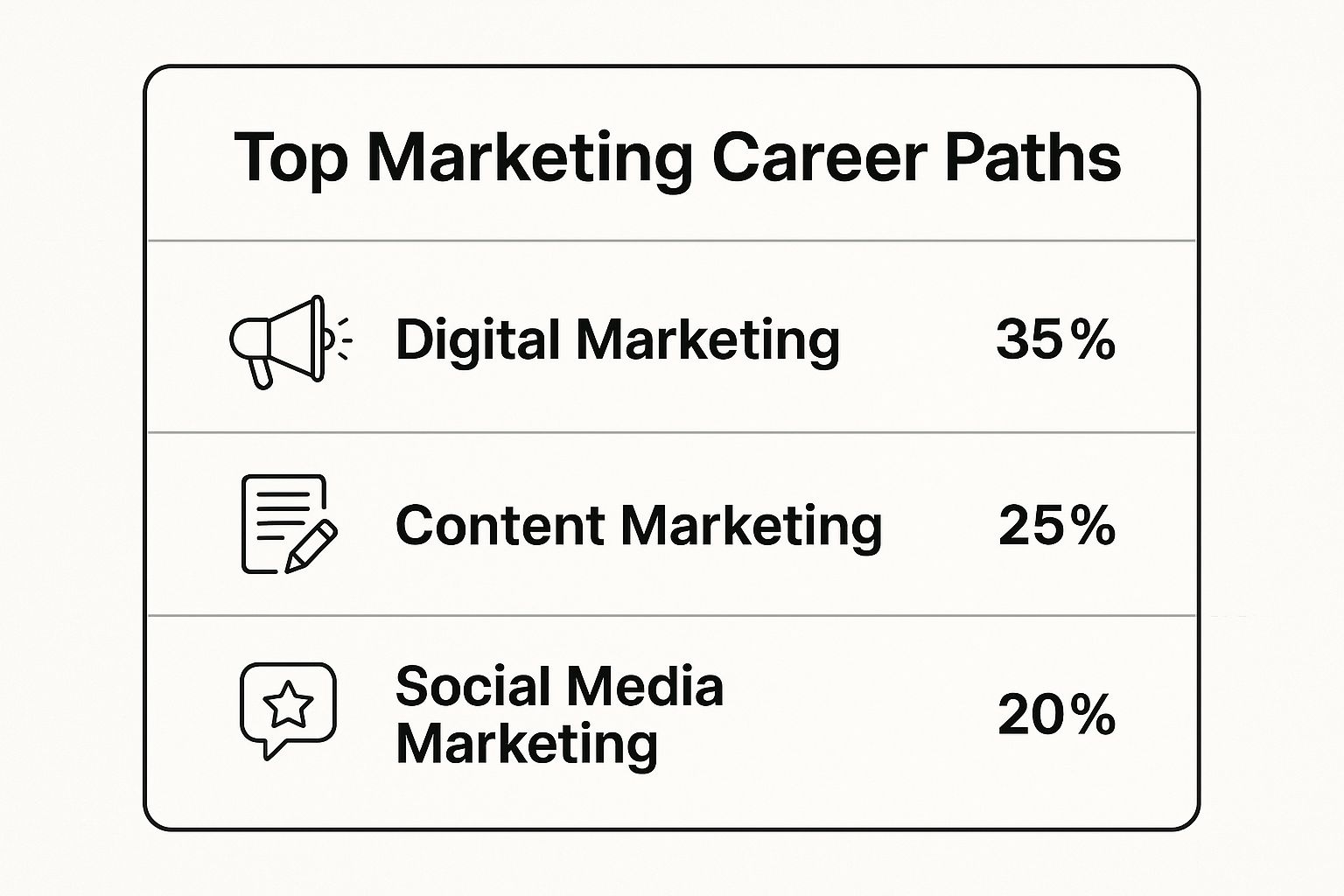
How to Get Into a Marketing Career in Tech Today
So, you want to break into marketing? It’s a fantastic field, but let’s be honest—it can feel like a classic catch-22. You can’t get a job without experience, but you can’t get experience without a job. The good news is there’s a way to short-circuit that frustrating loop.
The trick is to build foundational skills, create a portfolio that shows what you can do (even without a formal role), and start networking like a pro from day one. This whole process is about showing, not just telling, a hiring manager you’ve got the goods.
Your Launchpad into the Marketing World
Breaking into the marketing field often feels like trying to solve a puzzle when you don’t have all the pieces. The roles are incredibly diverse, the skills are always shifting, and the competition is fierce. Think of this guide as your roadmap, designed to swap that uncertainty for a clear, actionable plan to kickstart your new career.
Charting Your Course in Marketing
First things first, you need to understand the terrain. “Marketing” isn’t one job; it’s a massive ecosystem of specializations. You might be a natural at the data-heavy world of demand generation, a gifted storyteller perfect for content marketing, or have a knack for the strategic thinking behind product marketing. Figure out which path genuinely clicks with your skills and what you actually enjoy doing.
This breakdown shows some of the most in-demand marketing career paths right now, based on what companies are actually hiring for.

As you can see, Digital Marketing roles make up a huge piece of the pie, which makes it a really solid entry point if you’re just starting out.
Navigating Today’s Competitive Job Market
The marketing job market is more dynamic—and tougher—than ever before. In a recent survey, a staggering 68% of professionals said that landing a marketing job has gotten harder over the last five years. Why? A huge part of it is the demand for specialized tech skills, from AI integration to deep data analytics. You can read more about these job market trends on Marketing Dive.
This new reality means that being a “lifelong learner” isn’t just a cliché for your resume; it’s an absolute necessity to stay relevant.
The bottom line is this: Your ability to demonstrate tangible skills and adapt to new tools will matter far more than a perfect job history. Employers want to see what you can deliver today.
This guide gives you the framework to prove exactly that. We’ll walk through everything from learning the ropes to landing the role. Here’s what we’ll cover:
- Essential Skills: Pinpointing and mastering the core abilities that hiring managers are desperate for.
- Portfolio Creation: Building real projects that prove your value, no “real job” required.
- Strategic Networking: Making the kinds of connections that actually lead to opportunities. A great place to start is by checking out our guide on how to optimize your LinkedIn profile for job searching.
- Application Strategy: Crafting resumes that get noticed and nailing the interviews that follow.
To get started, let’s look at the big picture. I’ve put together a table that summarizes the core pillars you’ll need to focus on to launch your marketing career.
The Modern Marketing Career Launchpad
| Pillar | What It Is | Why It’s Critical |
|---|---|---|
| Skill Acquisition | Learning the hard and soft skills employers need, like SEO, analytics, and copywriting. | This is your foundation. Without the right skills, you can’t deliver results, and results are what get you hired. |
| Hands-On Projects | Creating a portfolio of work, such as a mock campaign, a blog, or social media content. | It’s tangible proof of your abilities. A portfolio shows what you can do, making you less of a risk for an employer. |
| Networking | Building genuine relationships with people in the industry, both online and in person. | Many of the best jobs are never even posted publicly. Your network is your access to the hidden job market. |
| Personal Branding | Polishing your online presence (especially LinkedIn) to reflect your marketing aspirations. | It’s how you control your narrative. Your personal brand tells a story about who you are and what you offer. |
Think of these four pillars as the legs of a table—if one is weak, the whole thing gets wobbly. Building them all up is your surest path to success.
Building Your Essential Marketing Toolkit

While you don’t need a specific degree to break into marketing, you absolutely need the right skills. Think of it this way: your marketing toolkit is your non-negotiable entry ticket. It’s what proves to hiring managers that you can deliver the results they’re desperate for.
This isn’t about memorizing textbook definitions. It’s about building a set of practical, day-one abilities. Modern marketing is a fascinating blend of art and science, demanding both a creative spark and a mind for data.
Mastering the Must-Have Hard Skills
Hard skills are the technical competencies that let you actually do the work of marketing. These are the specific, teachable skills you’ll see pop up on job descriptions again and again.
The key is to prioritize your learning based on the roles you’re most excited about. If a performance marketing job catches your eye, you’ll need to go deep on paid media platforms. On the other hand, if a content marketing role is your goal, strong SEO and writing skills are your bread and butter.
Here are the core areas every aspiring marketer should focus on:
- Search Engine Optimization (SEO): This is all about getting a website to show up higher in search results. Honestly, it’s fundamental to just about every digital marketing role today.
- Paid Media (PPC): Get your hands dirty with platforms like Google Ads and Meta Ads. Knowing how to drive traffic and leads through paid advertising is a superpower.
- Data Analytics: You have to get comfortable with data. Learn to navigate tools like Google Analytics to track how your campaigns are doing, understand what users want, and make smart, informed decisions.
- Content Creation: Whether it’s writing killer blog posts, shooting short-form videos for TikTok, or designing eye-catching graphics, creating stuff that people actually want to engage with is crucial.
You don’t need to spend a fortune to gain these skills. Platforms like Google’s Skillshop and HubSpot Academy offer free, industry-recognized certifications. They look fantastic on a resume and, more importantly, give you a solid foundation of real-world knowledge.
Developing Your In-Demand Soft Skills
Hard skills will get you the interview. Soft skills will get you the job and, ultimately, help you thrive. These are the personal attributes that determine how you work, collaborate, and adapt in a fast-moving environment.
Great marketers are part problem-solver, part storyteller, and part strategist. Getting good at these things is what will truly set you apart from candidates who only focus on the technical side of things.
Here’s what hiring managers are really looking for:
- Communication: Can you get your point across? This applies to everything from writing snappy ad copy to presenting campaign results to a client or just brainstorming with your team.
- Adaptability: The marketing world changes at lightning speed. New platforms pop up, algorithms get updated overnight, and consumer trends shift on a dime. Your ability to learn and pivot is essential for survival.
- Curiosity: The best marketers I know are endlessly curious. They constantly ask “why”—why did that campaign take off? Why are customers dropping off at this step? That drive is what leads to brilliant insights and innovation.
As you build this toolkit, you’ll also want to get familiar with the tech that makes the job easier. Many marketers are finding that understanding the best AI tools for job seekers and for marketing tasks can give them a real edge. Getting comfortable with these new technologies is key to future-proofing your career.
Creating a Portfolio That Speaks for Itself
A resume lists your experience, but a portfolio proves it. It’s the single best way to show a hiring manager what you can actually do, especially when you’re trying to break into marketing. Think of it as your secret weapon against the classic “you need experience to get a job” problem.
You don’t need to wait for someone to hire you to start building it. The whole point is to create your own experience by tackling real marketing problems head-on. This kind of initiative is exactly what companies are looking for.
From Zero to a Hire-Worthy Portfolio
The trick is to shift your mindset. Stop acting like a job seeker and start acting like a consultant looking for a problem to solve. Once you find one, use your marketing skills to fix it and then document everything. Just like that, you’ve got a case study.
Not sure where to start? Here are a few project ideas that work:
- Launch a Personal Blog: Pick a niche you’re genuinely interested in and start writing. You’ll immediately start building practical skills in SEO, content creation, and maybe even a little WordPress. Install Google Analytics to track your traffic so you have real numbers to show off.
- Build a Mock Campaign: Find a local business you love—or one you think could use a boost—and create a full marketing campaign for them. You could develop a content calendar, write sample ad copy, and design some basic graphics using a free tool like Canva.
- Volunteer Your Skills: Reach out to a small non-profit and offer to help with their marketing for free. Managing their social media accounts or writing a few email newsletters gives you tangible results and, just as importantly, a fantastic testimonial for your work.
The most crucial part of your portfolio isn’t just the finished project—it’s the story you tell about it. Frame everything as a case study. Clearly state the problem, walk through the steps you took to solve it, and highlight the results.
Structuring Your Portfolio for Impact
Once you’ve got a couple of solid projects under your belt, you need a professional-looking place to show them off. Don’t worry, you don’t need to be a web developer. A simple website on Squarespace, a detailed feature section on your LinkedIn profile, or even a polished PDF can do the job perfectly.
For every project you feature, make sure you include these key pieces:
- The Goal: What were you trying to achieve? (e.g., “Drive more foot traffic to a local coffee shop.”)
- Your Process: What did you actually do? (e.g., “I researched local competitors, built out three customer personas, and designed a 30-day Instagram content strategy.”)
- The Outcome: What happened? Use hard numbers whenever you can. (e.g., “My mock Instagram campaign was projected to boost engagement by 20% based on industry benchmarks.”)
Your portfolio is the visual proof that backs up the claims on your resume. The resume lists the skills; the portfolio brings them to life.
And speaking of resumes, if you want to make sure yours is telling the right story, our guide on what makes a resume stand out is packed with tips you can use right away. A powerful portfolio and a sharp resume are a combination that’s hard to ignore.
Getting Real-World Experience and Building Connections

A solid portfolio is your ticket to the game, but it’s the hands-on experience that really gets you noticed. Theory is great, but hiring managers want to see that you can apply what you know to solve real business problems. This is where you cross the bridge from “aspiring marketer” to an actual practitioner.
The demand for marketing specialists is definitely there—unemployment in the field was just 3.6% in Q4 2024. But it’s a competitive space. Growth is booming in tech and healthcare, and with over 85% of companies planning to spend more on AI in marketing, the skills in demand are shifting fast. You can dig into more marketing jobs statistics and trends to get a better feel for the landscape.
What does this all mean for you? It means getting practical experience isn’t optional; it’s absolutely critical.
Smart Ways to Get Your Foot in the Door
You don’t have to wait for a full-time offer to start beefing up your resume. The trick is to get scrappy and create opportunities for yourself.
Here are a few ways to do just that:
- Look for Internships: This is the classic route for a reason. Internships throw you right into the mix, letting you learn from pros, see how a marketing team actually works, and get your hands on real campaigns.
- Dip Your Toes into Freelancing: Platforms like Upwork or Fiverr are goldmines for new marketers. You can start small—maybe writing a few blog posts or managing a social media account for a week. It’s a fantastic way to build confidence and start collecting client testimonials.
- Volunteer Your Skills: Non-profits are almost always stretched thin and would love some marketing help. Find a cause you believe in and offer your services. You get valuable experience for your portfolio, and they get support they desperately need. It’s a true win-win.
Remember, your first “marketing job” might not be a salaried 9-to-5. It could be a three-month freelance project or a volunteer gig. What really matters is the experience you gain, the results you drive, and the story you can tell about it later.
Networking in a Way That Doesn’t Feel Awkward
Let’s be honest, the idea of “networking” can feel a little cringey. Forget the stuffy events and forced small talk. Today, it’s all about building genuine connections and making a name for yourself in the marketing community. You want people to know who you are before they even see your resume.
This requires a shift from passively scrolling to actively participating.
Making LinkedIn Your Best Friend
LinkedIn is an absolute powerhouse for networking, but only if you use it right. Blindly sending connection requests is a waste of time.
Here’s a better approach. Find a marketing leader you admire and look at their recent posts. Don’t just “like” it—leave a thoughtful comment that adds value to the conversation.
After you’ve engaged with their content a couple of times, your name will be familiar. Now, when you send a connection request, it’s not coming from a complete stranger. A quick note like, “Hi [Name], I really enjoyed your recent post on [Topic] and have been following your work. Would love to connect,” works wonders. It shows you’ve put in a little effort and are genuinely interested, which is how real professional relationships start.
Nailing Your Application and Interview

You’ve built your skills and created a solid portfolio. Now for the final push: creating an application that actually gets noticed. Your resume and cover letter are your opening pitch, and in the world of marketing, they need to do more than just list your history—they need to sell you.
This is where tailoring your application becomes non-negotiable. A generic, one-size-fits-all resume is a one-way ticket to the “no” pile. Instead, carefully read the job description and mirror its language. If they ask for “demand generation,” highlight your projects that drove leads. This simple step proves you’ve done your homework and aren’t just spamming applications.
And there’s plenty of opportunity out there. Worldwide marketing spending is expected to hit nearly $985 billion, which means companies are hungry for talent that can deliver results. This boom creates a massive demand for people who get data, digital channels, and modern strategy. You can see the full scope of the global marketing industry on Statista.
Translating Your Experience into Marketing Gold
A common worry I hear from career changers is that their past experience doesn’t count. I’m here to tell you that’s almost never true. The trick is learning how to reframe what you’ve already done through a marketing lens.
Think about it. Did you work in customer service? You have direct, on-the-ground experience with customer pain points and feedback. That’s invaluable. Came from a sales background? You’re a natural at understanding what motivates people and communicating value. These aren’t just skills; they’re marketing superpowers in disguise.
Let’s break it down:
- From Customer Service: You weren’t just answering phones. You were “gathering qualitative customer data to identify product improvement opportunities.”
- From Sales: Don’t just say you sold things. You were “executing bottom-of-funnel conversion strategies and articulating product value to drive revenue.”
- From an Admin Role: Your experience translates to “managing complex project timelines and coordinating cross-functional team deliverables.”
Your real goal is to connect your past actions to future marketing results. Get specific and quantify everything you can. “Managed social media” is forgettable. “Grew Instagram followers by 15% in three months through a targeted content strategy” gets you the interview.
Acing the Marketing Interview
When you land the interview, get ready for questions that dig into your thinking process, not just your knowledge. Hiring managers want to see how you solve problems.
They’ll likely throw a few common scenarios your way to see how you react on the fly:
- “Walk me through a marketing campaign you admire.” This is a classic test of your industry awareness. Don’t just pick something popular; break it down. Talk about its objective, who it was for, the channels it used, and—most importantly—why you think it worked.
- “How would you approach improving our current marketing?” This requires prep work. Spend some time on their website, social media, and content before the call. Come prepared with a couple of thoughtful, constructive ideas. It shows you’re already thinking like part of the team.
And please, don’t forget to ask them questions. This is your chance to interview them, too. Asking about their biggest marketing challenges, how they measure success, or their goals for the next quarter shows you’re a serious, strategic thinker ready to contribute from day one.
Your Top Questions About Breaking Into Marketing, Answered
Jumping into a new field is exciting, but it almost always comes with a healthy dose of uncertainty. If you’re mapping out your move into marketing, you probably have a few big questions swirling around. Let’s clear up some of the most common ones so you can move forward with a solid plan.
Do I Actually Need a Marketing Degree?
Let’s get this one out of the way: No, you absolutely don’t. While a formal degree can give you a good grasp of marketing theory, it’s not the golden ticket it once was. Honestly, in today’s marketing world, what you can do matters far more than where you went to school.
I can tell you from experience, every hiring manager I know would rather see a killer portfolio with real results than a specific degree on a resume. Your ability to show you can drive growth is what gets you hired.
Think about it from their perspective. Who would you rather hire? A fresh graduate with a 4.0 GPA but zero practical experience, or someone who taught themselves SEO and grew their personal blog to 10,000 monthly visitors? It’s a no-brainer. Focus on building tangible proof of your skills, not just your credentials.
What’s the Easiest Way to Get My Foot in the Door?
If you’re looking for the most accessible entry points, I almost always point people toward content marketing and social media marketing. The barrier to entry is incredibly low because you can start building a portfolio right now with little to no money.
- Content Marketing: Start a blog on a topic you’re passionate about. Write for free on platforms like Medium. This is a real-world sandbox for learning SEO, copywriting, and content strategy.
- Social Media Marketing: Offer to run the social media accounts for a local small business, a community group, or even a personal passion project. It’s a fantastic way to get your hands dirty with audience engagement, content calendars, and analytics.
These fields let you build foundational skills and create portfolio pieces without needing access to expensive, complex software from the get-go.
How Do I Get Experience If No One Will Hire Me?
Ah, the classic “need experience to get experience” problem. The trick is to stop waiting for someone to give you a job title. Start being a marketer today by creating your own opportunities.
Here are a few proven ways to build that crucial experience:
- Volunteer for a Non-Profit: Small charities are almost always short on resources and would be incredibly grateful for marketing help. You get real-world projects for your portfolio and a glowing reference.
- Find Freelance Gigs: Hop on platforms like Upwork or Fiverr and look for small, entry-level projects. You’ll get paid to learn and start building a client list.
- Create a Spec Project: Pick a brand you love and build a mock marketing campaign for them. Outline the strategy, define the target audience, and create some sample ad creative. This is a powerful way to showcase your strategic thinking to potential employers.
Realistically, How Long Will This Take?
The timeline really depends on your commitment, but most people who are serious about making the switch can do it within six to twelve months. That’s a realistic window to learn the core skills, create a few solid portfolio projects, and start making connections in the industry.
Your pace is directly tied to the hours you put in. Someone dedicating 20 hours a week will obviously progress faster than someone with only a few hours to spare on weekends. The most important thing is consistency. Set a realistic plan and stick with it—that’s how you build the momentum to land that first role.
Ready to build a resume that gets you noticed? Jobcamp uses AI to instantly create tailored resumes and cover letters that are optimized for any job you apply for. Stop wasting time and start landing more interviews today. Get started for free at Jobcamp.

